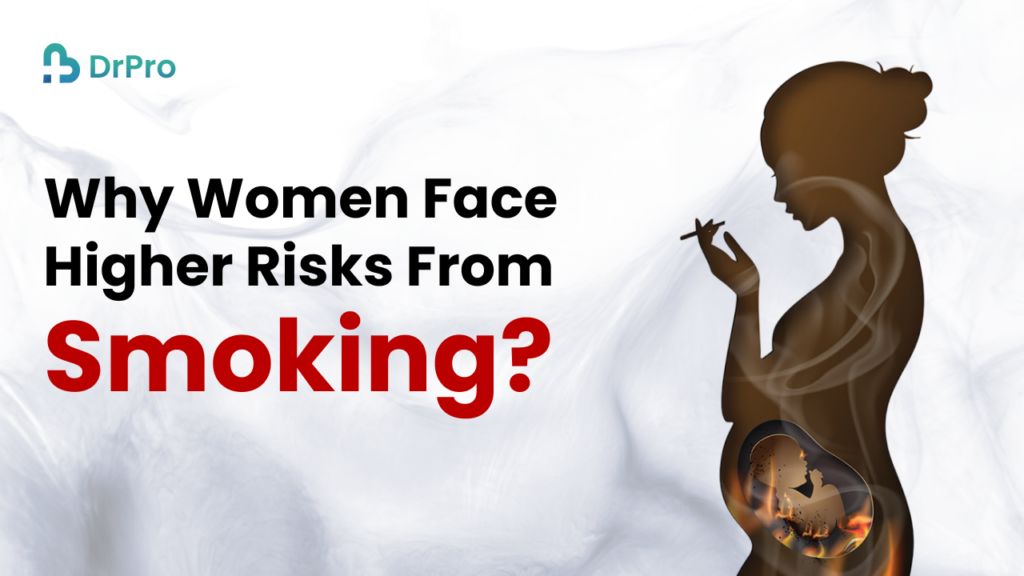Smoking harms everybody, yet certain health risks are either increased or directly caused in Women smoking due to biological and hormonal considerations. Studies show that female smokers are at increased risk compared to their male counterparts for serious ailments related to lung and heart disease and reproductive health.
Reasons for Increased Vulnerability of Women Smoking Related Health Risks and Problems:
1. Increased Risk of Lung Diseases
a) Higher Risk of Lung Cancer
Smoking remains the main cause of lung cancer, and studies show that female smokers are more prone to develop lung cancer than males, irrespective of the number of cigarettes smoked. This is due to an increased susceptibility of female lungs to exogenous toxins in tobacco.
b) Greater Risk of Chronic Obstructive Pulmonary Disease (COPD)
With females getting affected faster and at lighter smoking levels than males with this disease, COPD ultimately hits very hard and further on with severe difficulties in breathing and reduced lung function. COPD stands for chronic obstructive pulmonary disease, and this refers to a set of diseases in the lungs, including chronic bronchitis and emphysema.
2. Higher Risk of Heart Disease and Stroke
a) Smoking Increases Heart Disease Risk More in Women
Smoking affects the heart and blood vessels, thus increasing heart attack and stroke-related risk factors. According to research, female smokers reportedly have a 25% higher risk of developing heart disease than male smokers.
b) Greater Stroke Risk
Smoking affects circulation and increases the risk of the formation of blood clots in brain, which is fatal if caused by stroke. Women smoking and taking birth control pills face the additional risk of strokegain with hormonal change rendered by the pill favors clotting of the blood.
3. Negative Effects on Reproductive Health
a) Fertility Problems
Smoking affects the ovaries and reduces the chance of becoming pregnant. Women smoking who smoke are more likely to have trouble conceiving, with a higher risk of miscarriages.
b) Early Menopause and Menstrual Issues
Early menopause is an effect of smoking, which would have occurred 1-2 years earlier in women who smoke than in women who are non-smokers. It increases the risk of irregular periods and severe menstrual cramps.
c) Increased Risk of Pregnancy Complications
There are multiple risks for a baby when a woman smokes during pregnancy, including:
- Premature birth
- Low birth weight
- Stillbirth
- Risk of Sudden Infant Death Syndrome (SIDS)
Quitting smoking before or during pregnancy significantly reduces these risks and improves the baby’s health.
4. Greater Risk of Osteoporosis and Bone Fractures
Smoking weakens bones and increases the risk of osteoporosis (bone thinning), owning this greater property of late fractures particularly to women after menopause. Women who smoke in their advanced age have a high risk of suffering hip fractures.
5. Faster Skin Aging and Wrinkles
Smoking harms collagen and elastin, two proteins necessary for healthy skin. Consequently, there will be:
- Early wrinkle formation
- Dull, dry skin
- Signs of premature aging around the eyes and mouth
Women Who Smoke Often Develop Deep Wrinkles Faster than Non-Smokers.
6. Higher Risk of Depression and Anxiety
Studies denote that depressed and anxious states seem to affect Women smoking more than men. One would conjecture that smoking may alleviate stress for a time, but as nicotine dependence develops, it causes more severe mood swings, increased anxiety, and poorer mental functioning.
7. Increased Risk of Certain Cancers
Smoking predisposes women to different cancers other than lung cancers:
- Cervical cancer: The incidence is twice for women who smoke;
- Breast cancer: Some studies indicate a correlation between smoking and breast cancer risk;
- Bladder cancer: Bladder cancer is ranked among the more common cancers in females due to smoking.
8. Smoking and Birth Control: A Dangerous Combination
Women who smoke and take oral contraceptives are at an elevated risk of developing blood clots, having heart attacks, and suffering from strokes. This risk is markedly elevated for women over the age of thirty-five.
Doctors are fiercely against smoking while on the pill, as this practice may lead to critical complications.
9. Passive Smoking: Risks for Women and Children
Women smoking exposed to second-hand smoke are at risk of suffering from the same health issues even without being smokers themselves. Passive smoking increases the risk for:
- Lung cancer
- Heart disease
- Pregnancy complications.
For children, exposure to secondhand smoke can lead to:
- Frequent respiratory infections
- Asthma
- Low birth weight (if the mother smokes during pregnancy)
drpro It is vital to avoid smoky places and keep homes smoke-free to protect both women and their children. Let’s create a healthier space for everyone!
📲 Follow us on Facebook, Instagram, Twitter, LinkedIn & YouTube for more wellness tips!
10. Why Quitting Smoking is Essential for Women
The faster a woman gives up smoking, the more health benefits she will attain.
Short-Term Benefits of Quitting
- Breathing and lung function improve
- Better circulation
- Less risk of heart attack and stroke
- Better skin with fewer wrinkles
Long-Term Benefits of Quitting
- Lower rates of lung cancer, heart disease, and osteoporosis
- Healthier fertility-enhanced pregnancy outcomes
- Longer survival
Conclusion
Females are at a higher health risk posed by smoking, given the hormonal and biological differences involved. Smoking can lead to lung disease, heart disease, reproductive issues, osteoporosis, and mental difficulties.
Quitting smoking is a very good decision for any woman when it comes to protecting her health and well-being. It is attainable through support such as cessation programs, nicotine replacement therapies, and counseling.
Frequently Asked Questions
Q1. Why Women smoking are at a greater risk of tobacco-related diseases?
The response of women’s lungs, heart, and hormones to tobacco smoke is different than that of men, and this makes them vulnerable to lung disease, heart disease, and reproductive health issues.
Q2. Does tobacco affect pregnancy and fertility?
Fertility may be lowered by tobacco smoking, and miscarriage risk is increased in ways, such as causing pregnancy complications of low birth weight and premature birth.
Q3. What are the effects of smoking on women’s skin and aging?
The collagen and elastin damage from smoking leads to early wrinkles, dryness, and dullness, providing women with an older appearance.
Q4. Does secondhand smoke harm women and children?
Yes, women become affected with higher risks of lung cancer, heart disease, and complications during pregnancy due to passive smoking, while it becomes harmful for children by causing asthma as well as respiratory infections.
Q5. How can quit women smoking?
women smoking wishing to quit smoking use nicotine replacement therapy, counseling, and cessation programs; support from friends and family is equally important.


